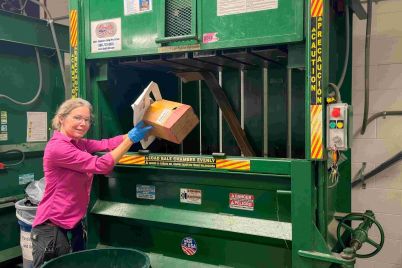
A vice president and the chief financial officer, Bill Johnson, speaks to the board of trustees about tuition. Gray Bancroft | Washtenaw Voice
BY TAYLOR ROBINSON
Editor
Washtenaw Community College’s board of trustees discussed multiple scenarios for tuition rates for the 2016-2017 academic school year. The March 22 presentation was led by Bill Johnson, a WCC vice president and chief financial officer.
While community colleges across the state are struggling with maintaining tuition rates, a tuition freeze for in-district rates has been proposed, while increasing rates for out-of-district and out-of-state WCC students.
In-district rates would then be proposed to increase at a 1 percent rate, or $1, in 2018 and 2019. This scenario is preferred by Johnson and his team. According to his presentation, “The college can support a 0 percent in-district rate increase for FY 2017, which is forecasted to reduce FY 17 tuition revenue by approximately $150,000.”
Using this scenario would support the strategic recruitment and retention plans, and the college’s goal of maintaining an affordable cost for students, Johnson said.
“The college has worked very, very hard on this affordability issue,” he said. “We are blessed because of the level of property tax revenue that our residents provide to us that helps in part keep it (tuition) down.”
The local property tax provided $47.7 million for 2014-2015. The forecasted property tax is set at $49.1 million for 2015-2016, and up to $49.7 million projected for 2016-2017. Because of the level of property taxes, along with state aid ranging from $13-14 million, Johnson’s team tries to make tuition rates as competitive as possible with other community colleges in the state.
Overall, WCC ranks 23 out of 28 Michigan community colleges for tuition rates. For in-district full time costs from 2011-2015, WCC had an 8 percent total increase over five years, while the average total increase for college’s was 19 percent.
Another proposed scenario would be to keep the same tuition increases as FY 2016, projecting a 1 percent increase for in-district tuition, 2 percent for out-of-district, 2.5 percent for out-of-state, and 3 percent for international.
The third scenario includes increasing in-district rates by 1 percent, out-of-district by 2 percent, and out-of-state by 3 percent, for the next three fiscal years. International tuition would initially increase by 6 percent, tapering off to 4 percent for FYs 2018 and 2019.
The board was also presented with enrollment projection and how it plays a significant role in determining the college’s costs and tuition rates for students. Vice Chair Diana McKnight-Morton expressed concern at the decreasing enrollment rate.
“We’re seeing this slope getting more slippery because the economy is going up,” McKnight-Morton said, adding that the better the economy gets, the less people think they need to go back to school. “It’s really scary to think that now we are really going to go down, back to the late 90s, because we were doing O.K., but not great… Here we are going to be O.K. for the next few years, but what can we do in the meantime when the crash starts coming down in 2018? That’s something to really start thinking about.”
The board will continue to discuss rates at their next meeting on April 26. If the board comes to a decision, they will vote on tuition rates for the following school year.
“Last year, I took this on in an effort to demonstrate that it would be possible to hold the line on the tuition and I really thank you for embracing that for this year for the people that are in-district who already pay taxes,” said trustee Dave DeVarti.

